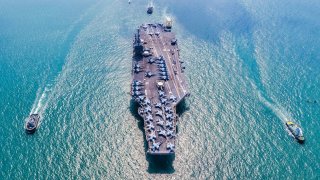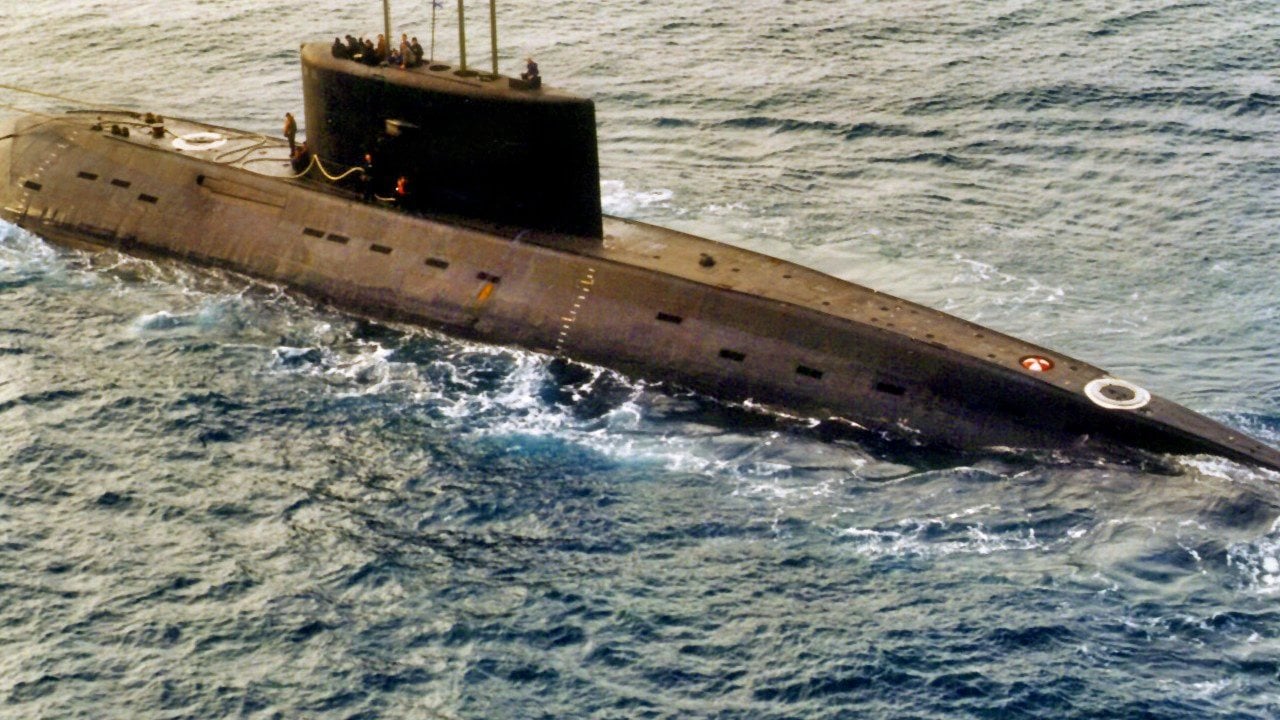Brandon J. Weichert
 Summary: In 2007, a Chinese Song-class diesel submarine showcased its stealth by surfacing within torpedo range of the USS Kitty Hawk during a US Navy exercise, demonstrating the vulnerabilities of American naval power. This event, along with China's destruction of a satellite, signaled its growing military capabilities, particularly in anti-access/area denial (A2/AD) strategies and advanced torpedo technology. Despite incidents where both nuclear and non-nuclear submarines have successfully "sunk" US carriers in simulations, the US continues to invest heavily in aircraft carriers without adequate countermeasures against such threats. China's development of advanced torpedoes and unmanned underwater vehicles (UUVs), alongside the over-budget and problematic Ford-class carriers, suggest that the US might be maintaining an outdated model of naval power, overlooking the shifting dynamics of modern naval warfare and the rising capabilities of adversaries like China.
Summary: In 2007, a Chinese Song-class diesel submarine showcased its stealth by surfacing within torpedo range of the USS Kitty Hawk during a US Navy exercise, demonstrating the vulnerabilities of American naval power. This event, along with China's destruction of a satellite, signaled its growing military capabilities, particularly in anti-access/area denial (A2/AD) strategies and advanced torpedo technology. Despite incidents where both nuclear and non-nuclear submarines have successfully "sunk" US carriers in simulations, the US continues to invest heavily in aircraft carriers without adequate countermeasures against such threats. China's development of advanced torpedoes and unmanned underwater vehicles (UUVs), alongside the over-budget and problematic Ford-class carriers, suggest that the US might be maintaining an outdated model of naval power, overlooking the shifting dynamics of modern naval warfare and the rising capabilities of adversaries like China.China's Military Advancements: A Growing Threat to US Aircraft Carriers
In 2007, the People’s Liberation Army Navy (PLAN) deployed one of its old Song-class diesel submarines to stalk a US Navy carrier battle group that was conducting a massive military exercise near China’s shores.
The Chinese submarine did something unbelievable.
As the US Navy battle group was going about its business, the crews of her expensive and sophisticated warships all comfortable in the knowledge that they had the best onboard defenses that US tax dollars could buy—and no one in Asia would be crazy enough to dare come close to them while at sea—the Chinese Song-class submarine surfaced within visual (and, therefore, torpedo) range of the battle group’s flagship, the USS Kitty Hawk.
Shocked and humiliated, the crew aboard the nuclear-powered aircraft carrier knew that they’d been bested by an antiquated, tiny diesel-submarine. This Song-class submarine could have easily popped off a couple of torpedoes that likely would have found their mark in the Kitty Hawk’s hull, if the Chinese sub skipper had desired to send the legendary American carrier (which has since been retired from service) to the bottom of the drink.
Rather than fire off their torpedoes at the American carrier that had gotten caught with their pants down and rear-ends hanging out, though, the Chinese sub crew decided to come out from their submarine and mock the crew of the Kitty Hawk (who were watching angrily through their binoculars).
Beijing was sending a message to Washington: do not underestimate us.
The year that this incident took place—2007—is the same year that the Chinese military surprised the world by launching an anti-satellite weapon that destroyed a derelict Chinese weather satellite in orbit. This demonstration was not only provocative, as well as a signal that Chinese offensive capabilities were advancing, but the demonstration also created the world’s largest debris field in orbit.
China’s Evolving Threat to US Aircraft Carriers
Since that time, China’s military has married its counterspace and submarine capabilities to potent anti-access/area denial (A2/AD) defenses that are meant to stunt the otherwise potent abilities of American naval and air force to reliably project power into regions that China deems to be its own.
And the incident with the USS Kitty Hawk being bested by a rickety Chinese Song-class submarine is not the only time a foreign submarine has gotten within firing range of a gigantic, expensive American aircraft carrier. A Swedish Gotland-class (also non-nuclear) got within firing range of a US aircraft carrier during a military exercise in the Pacific Ocean in 2005. In that wargame, the Gotland-class submarine sank the US carrier.
But it isn’t only non-nuclear submarines that have gotten famous—or infamous, depending on who you ask—it is also nuclear submarines. Such as the French Navy’s Rubis-class submarine, which sank the Nimitz-class aircraft carrier, USS Theodore Roosevelt, during a wargame in 2015.
The point here is that China could easily sink, or at least damage, a US flat top at the outset of a war between the two major powers with just a handful of torpedoes from a submarine. Add in China’s impressive A2/AD capabilities and you just might have rendered the US aircraft carrier—the primary surface warship for the US Navy—obsolete. And if the Navy still risked sending these monstrosities into battle, the likelihood that they would be destroyed or irreparably damaged before they could prove their utility in combat with a near-peer rival, like China, is great.
China’s Newest Torpedoes and UUVs
Since 2021, China’s primary torpedo is the Yu-6. It is modeled after the successful US Navy Mk 48 dual-purpose, anti-submarine (ASW) and anti-surface (ASuW) torpedo, the Yu-6 is a true threat to the safety of US flat tops operating in a potentially contested environment, like the Taiwan Strait, the South, or East China Seas. The Yu-6 was first developed in 2005, likely with Russian assistance, as the Yu-6 possesses a “wake-homing” mode along with active and passive homing that helps the torpedo hunt its unsuspecting and helpless prey. Charlie Gao reported in these pages back in 2021 that the new Yu-6 is made of a “novel synthetic material shell.”

Then there’s the new “cross-medium” supersonic missile-torpedo that Li Pengfei and his team at the National University of Defense Technology in Changsha, China, claimed they had created in 2022. This antiship supersonic missile is fired into the air and, as it reaches its terminal velocity, it dives into the ocean, becoming a supersonic torpedo. What’s more, it can change its course to evade incoming attack from shipboard defenses.
While this technology remains highly experimental, the fact of the matter is that China has more than enough ways to render all of America’s aircraft carriers combat ineffective. That’s to say nothing of the risk that China’s increasingly sophisticated and ever-enlarging arsenal of unmanned underwater vehicles (UUV) pose to the safety of US warships.
America is Blindly Committed to a Flawed Model of Naval Power Projection
And, with a dearth of viable replacement systems to continue projecting American power into contested regions, China’s military may have the upper-hand it needs to box the US military out and pressure its neighbors into accepting a new Chinese-led regional order.
The newest US carriers, the Ford-class, went over-budget and overtime in its development. The first unit, the USS Gerald R. Ford, cost $13 billion. It took more than a decade to build, and it went over-budget. Since being commissioned in 2017, the carrier has had a slate of technical problems. There is no evidence to suggest that America’s carriers—or their attendant support warships—have developed reliable countermeasures to these forms of attack. In other words, the United States has invested far too much money in a system as relevant to modern warfare as the trireme.
Rather than acknowledge this sad reality, the Navy and Congress keep doubling-down, hoping that somehow the Chinese threat is overhyped. It is not. And the carriers will be destroyed by torpedoes fired from old Chinese subs that cost a fraction of what the fancy nuclear-powered US aircraft carries cost.
About the Author
Brandon J. Weichert, a National Interest national security analyst, is a former Congressional staffer and geopolitical analyst who is a contributor at The Washington Times, the Asia Times, and The-Pipeline. He is the author of Winning Space: How America Remains a Superpower, Biohacked: China’s Race to Control Life, and The Shadow War: Iran’s Quest for Supremacy. His next book, A Disaster of Our Own Making: How the West Lost Ukraine, is due October 22 from Encounter Books. Weichert can be followed via Twitter @WeTheBrandon.
No comments:
Post a Comment